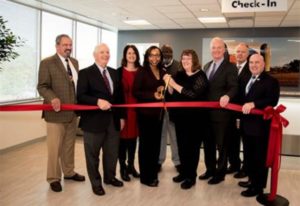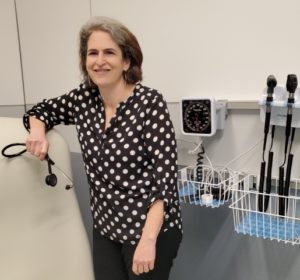WASHINGTON — The journey of Robin Peck, MD, to VA was short and straight.
Like many medical students at George Washington University, she rotated through the DC VAMC both as a student and a resident in internal medicine. Her first job after her residency was at the VA—opening a small community clinic in southeast Washington, DC.
That was 21 years ago.
Today Peck oversees the operations of Women’s Health at the DCVAMC and coordinates care at the community-based outpatient clinics (CBOCs) in the medical center’s catchment area, which includes DC, Maryland and Virginia.
It might seem like a strange dual role, but the two intersect in Peck’s interest in health disparities and how to close the gap between VA care and the people who need it most.
“I had a strong liberal arts education and have always had an interest in how systems work and how they work better for some than others,” Peck explained.
When Peck arrived at the DCVAMC 21 years ago, there were only about 4,000 women enrolled there. Today there are nearly five times as many. But VA is only able to properly care for those women because Peck and other healthcare leaders saw the gap in care and started VA on a path to narrowing it.
“Our VAMC works very closely with trainees from GW, Georgetown and USUHS, and it was really clear that clinicians were being trained in healthcare and seeing very few women,” Peck said. “You could complete a three-year training and really just have a handful of women on your panel. A very strong group at central office really pushed to have an organized system of women’s healthcare, and that went hand in hand with providing training.”
Peck’s first foray into helping VA better prepare for treating women veterans was working with rotating medical residents to teach them how to provide basic healthcare services to women, such as contraception, cervical cancer screening, and hormone replacement.
“They were all these things that are pretty routine outpatient medicine but can be unique at VA,” she explained.
Today, the DC VA has a robust women’s health program, both at the medical center and the CBOCs.
“We have 21 women’s health primary care providers, mostly physicians, who have an interest and a skill set in proving basic

Robin Peck, MD, third from left, at the ribbon cutting for a new VA Community-Based Outpatient Clinic (CBOC) in Lexington Park, MD, last year. With her were, l to r, the secretary of the Maryland Department of Veterans Affairs, George Owings III; Sen. Ben Cardin (D-MD); LaChrisa Jennings, DO; Kim Larsen, MD; Taylor Terrence of Rep. teny Hoyer’s Office; Sen. Chis Van Hollen (D-MD): Brian Norris, the building owner, and Medical Center Director, Michael Heimall. Photo from DCVAMC website.
primary care but really understanding women’s healthcare,” Peck explained. “We’ve had an in-house GYN program for the last three years, with surgery being done at our hospital. Prior to that, we didn’t have GYN surgery, even though some of what they do is a mainstay of women’s health, including providing IUDs and doing higher level evaluations of abnormal pap smears.”
Peck also has helped oversee the recruitment of a breast surgeon, two psychologists, including a military sexual trauma specialist and a clinician from VA’s Central Office who provides infertility services. Peck and chief of gynecology Dr. Maria Vargas were recently awarded a Joint Incentive Fund grant to launch a gynecology program at a CBOC in neighboring Montgomery County, MD.
“We’re going to partner with DoD folks to provide more services,” Peck explained. “We want to take advantage of the fact that we have two parallel systems that sometimes take care of the same patients.”
While she’s grateful for the increase in options for women at VA, Peck said she’d love to see a future where providing women’s healthcare was the standard for VA physicians rather than the exception.
“I still find it unusual that some physicians provide primary care but don’t provide women’s healthcare services,” Peck said. “I would like it just to be the expectation that our trainees learn about half of our population and feel comfortable and confident and incorporate it without thinking about it.”
During Peck’s tenure, DC’s CBOCs have grown at the same rapid pace as its women’s health program. When Peck began working at the Southeast clinic, it was one of two operating in the catchment area. Each had a physician, a nurse, and a mental healthcare provider that would rotate through one or two days each week.
Now Peck coordinates care at six large clinics, which see Now Peck coordinates care at six large clinics, which see 20,490 patients annually. Last month, she opened a new clinic in Charlotte Hall, MD—a replacement for one that VA had outgrown.
“We’ve outgrown most of the physical footprint of our older clinics,” she explained. “We just can’t grow anymore within our walls. We’ve turned closets into offices. We’ve shared spaces. In order to grow both the number of services and the number of patients, we have to shed our shell and get a bigger footprint.”
And Peck certainly expects more veterans to be visiting their CBOCs in coming years.
“We are expecting significant growth, because in this country health insurance is often tied to employment, and the levels of unemployment are rising, so we’re expecting more veterans to come to us for healthcare,” she explained. “But I always want people to choose us. because we provide higher level care than they can find in the community.”
That’s one of the many reasons she’s stayed with VA for her entire career; still treating her own panel of patients at the southeast DC clinic and still finding new ways to close the health disparity gap.
“VA can be a system that often seems very rigid and complicated, but I’ve had a very creative career,” Peck declared. “VA has provided me a career where I could create things.”

